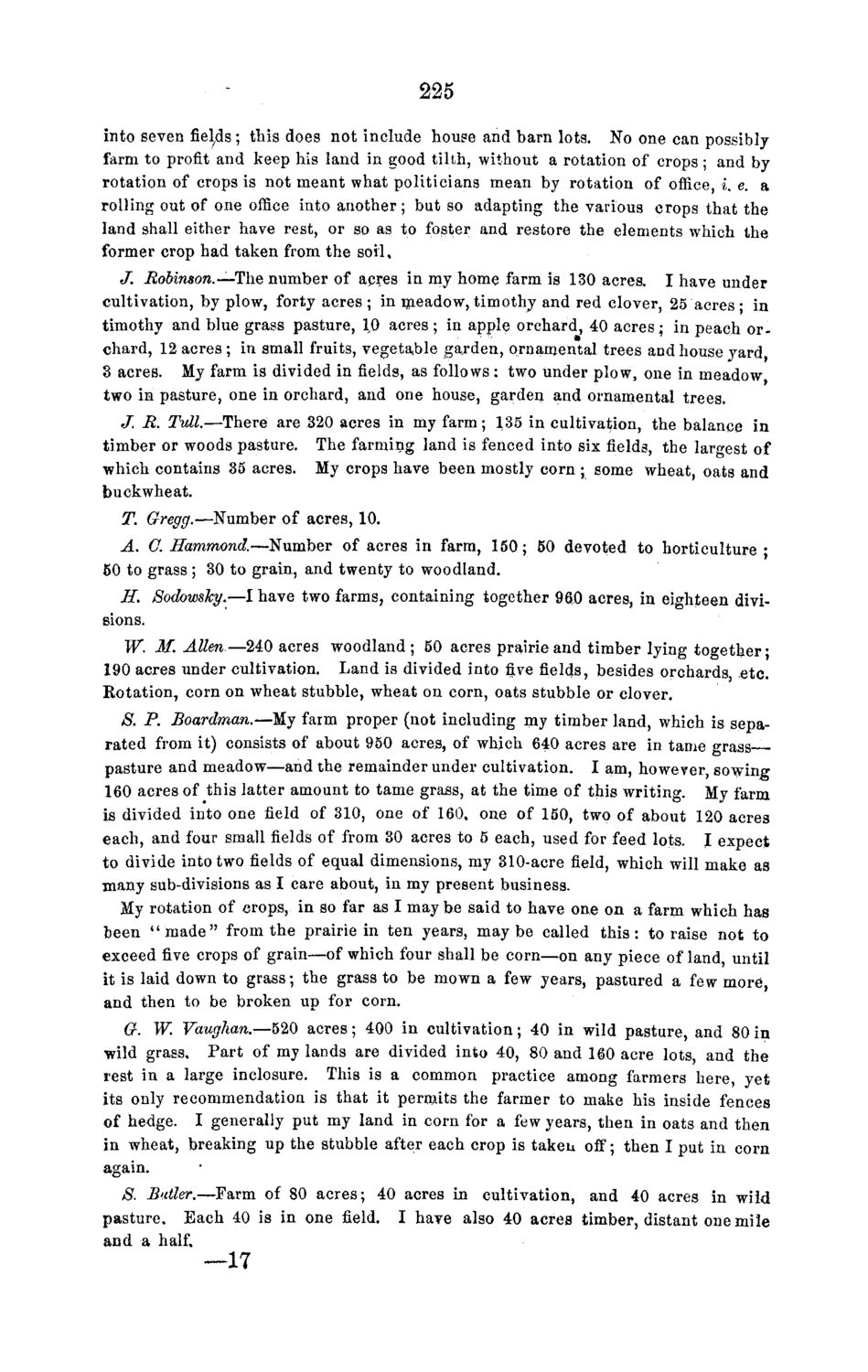| |
| |
Caption: Board of Trustees Minutes - 1868
This is a reduced-resolution page image for fast online browsing.

EXTRACTED TEXT FROM PAGE:
225 into seven fields; this does not include house and barn lots. No one can possibly farm to profit and keep his land in good tilth, without a rotation of crops; and by rotation of crops is not meant what politicians mean by rotation of office, i. e. a rolling out of one office into another; but so adapting the various crops that the land shall either have rest, or so as to foster and restore the elements which the former crop had taken from the soil, J. Robinson.—-The number of acres in my home farm is 130 acres. I have under cultivation, by plow, forty acres ; in meadow, timothy and red clover, 25 acres • in timothy and blue grass pasture, 10 acres; in apple orchard, 40 acres; in peach orchard, 12 acres ; in small fruits, vegetable garden, ornamental trees and house yard 3 acres. My farm is divided in fields, as follows : two under plow, one in meadow two in pasture, one in orchard, and one house, garden and ornamental trees. J. E. Tull.—There are 320 acres in my farm; 135 in cultivation, the balance in timber or woods pasture. The farming land is fenced into six fields, the largest of which contains 35 acres. My crops have been mostly corn ; some wheat, oats and buckwheat. T. Gregg.—Number of acres, 10. A. C. Hammond.—Number of acres in farm, 150; 50 devoted to horticulture • 50 to grass ; 30 to grain, and twenty to woodland. H. Sodowsky.—I have two farms, containing together 960 acres, in eighteen divisions. W. If. Allen—240 acres woodland ; 50 acres prairie and timber lying together; 190 acres under cultivation. Land is divided into five fields, besides orchards etc. Rotation, corn on wheat stubble, wheat on corn, oats stubble or clover. JS. P. Boardman.—My farm proper (not including my timber land, which is separated from it) consists of about 950 acres, of which 640 acres are in tame g r a s s pasture and meadow—and the remainder under cultivation. I am, however, sowing 160 acres of this latter amount to tame grass, at the time of this writing. My farm is divided into one field of 310, one of 160, one of 150, two of about 120 acres each, and four small fields of from 30 acres to 5 each, used for feed lots. I expect to divide into two fields of equal dimensions, my 310-acre field, which will make as many sub-divisions as I care about, in my present business. My rotation of crops, in so far as I may be said to have one on a farm which has been " m a d e " from the prairie in ten years, maybe called this: to raise not to exceed five crops of grain—of which four shall be corn—on any piece of land, until it is laid down to grass; the grass to be mown a few years, pastured a few more, and then to be broken up for corn. G. W. Vaughan.—520 acres; 400 in cultivation; 40 in wild pasture, and 80 in wild grass. Part of my lands are divided into 40, 80 and 160 acre lots, and the rest in a large inclosure. This is a common practice among farmers here, yet its only recommendation is that it permits the farmer to make his inside fences of hedge. I generally put my land in corn for a few years, then in oats and then in wheat, breaking up the stubble after each crop is taken off; then I put in corn again. 8. Butler.—Farm of 80 acres; 40 acres in cultivation, and 40 acres in wild pasture. Each 40 is in one field. I have also 40 acres timber, distant one mile and a half. —17
| |